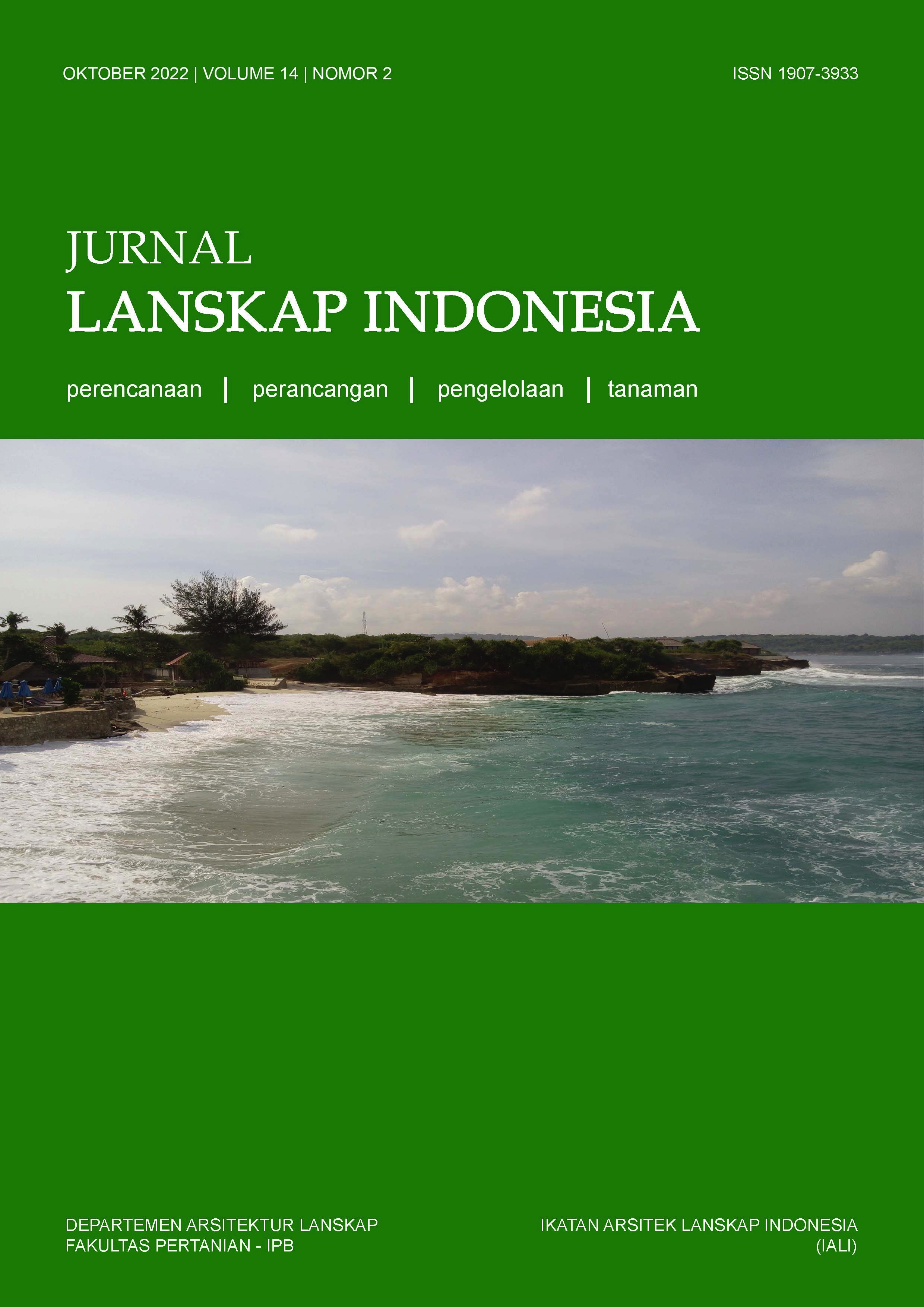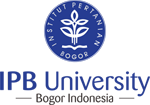Integrasi Analisis Preferensi Visual dan Bahaya Lanskap dalam Perencanaan Wisata di Taman Hutan Raya Ir. H. Djuanda, Bandung
Abstract
Ir. H. Djuanda Forest Park, is a natural tourism destination located in Bandung, West Java and in low land parts of Gunung Pulosari, passed by Cikapundung river stream. This research aimed to recommend the appropriate tourism planning to be implemented in the Ir. H. Djuanda Forest Park. Through landscape hazard analysis within slope gradient and soil element contained, we developed landscape sensitivity map. The result shows that 65,508% from the total area is a high sensitivity land. Beside that, only 4,335% from the total area is a low sensitivity lands and can be explored for active tourism attraction. The visual preference analysis was held to identify the potential attractiveness of many tourisms object in this area. The high potential object is dominanated with natural landscape objects and man-made object is the less potential. Almost all of the potential objects are located in high sensitivity land. Unfortunately, the uninterested object with unclear function is located in low sensitivity land which it is suitable for intensive recreation activities. The planner of this area should consider the role of limited activities and facilities development in low caring capacity land. For conservation purpose, planting endemic vegetation in sensitive landslide land should be carried out in order to maintain forest sustainability.
Downloads
References
Adelia, D., Kaswanto. 2021. Analysis of vegetation biodiversity and urban park connectivity as landscape services provider in Bogor city. IOP Conference Series: Earth and Environmental Science, 694(1), 12020. https://doi.org/10.1088/1755-1315/694/1/012020
Albrecht, J. 2017. Introduction to Visitor Management in Tourism Destinations. Visitor management in tourism destinations, pp.3-8. Wallingford: CABI Publishing.
Arnberger, A., Eder, R., Allex, B., Preisel, H., Ebenberger, M., Husslein, M. 2018. Trade-offs Between Wind Energy, Recreational, and Bark-Beetle Impacts on Visual Preferences of National Park Visitors. Land Use Policy, 76(C), 166-177.
Arnberger, A., Schneider, I. E., Ebenberger M., Eder, R., Venette, R. C., Snyder, S. A., Gobster, P. H., Choi, A., Cottrell, S. 2017. Emerald Ash Borer Impacts on Visual Preferences for Urban Forest Recreation Settings. Urban Green, 27, 235–245. https://doi.org/10.1016/j.ufug.2017.08.004
Bebi, P., Bast, A., Helzel, H., Schmucki, G., Brozova, N., Bühler, Y. 2021. Avalanche Protection Forest: From Process Knowledge to Interactive Maps. IntechOpen. DOI: 10.5772/intechopen.99514.
[BKSDA] Balai Konservasi Sumberdaya Alam. 2008. Pesona Wisata Kawasan Pelestarian Alam Taman Hutan Raya Ir. H. Djuanda, Dinas Kehutanan Propinsi Jawa Barat. Bandung. 64 hal.
Douglass, W. Robert. 2000. Forest Recreation. New York: Pergamont Press. 389 p.
Ervina, E., Wulung, S. R. P. and Octaviany, V. 2020. Tourist perception of visitor management strategy in North Bandung Protected Area. J Bus Hosp Tour, 6(2), pp.303-314. https://dx.doi.org/10.22334/jbhost.v6i2
Fandeli, C., Nurdin, M. 2005. Pengembangan Ekowisata Berbasis Konservasi di Taman Nasional. Fakultas Kehutanan Universitas Gadjah Mada, Pusat Studi Pariwisata UGM, Kantor Kementrian Lingkungan Hidup. Yogyakarta. 256 hal.
Febriana, N. P. R., Kaswanto. 2015. Tourism Track Management of Cibeureum Waterfall as a Provider of Landscape Beautification Service at Gunung Gede Pangrango National Park. Procedia Environmental Sciences, 24, 174–183. https://doi.org/10.1016/j.proenv.2015.03.023
Hassanli, N. 2017. The Social and Political Dimensions of Visitor Management: Rural Home-Based Accommodations. In J. N. Albrecht (Ed.). Visitor management in tourism destinations (pp. 33–44). Wallingford: CABI Publishing.
Jahani, A., Rayegani, B. 2020. Forest Landscape Visual Quality Evaluation Using Artificial Intelligence Techniques as a Decision Support System. Stoch Environ Res Risk Assess, 34, 1473–1486. https://doi.org/10.1007/s00477-020-01832-x
Kebete, Y., Wondirad, A. 2019. Visitor Management and Sustainable Destination Management Nexus in Zegie Peninsula, Northern Ethiopia. Journal of Destination Marketing & Management, 13, 83-98, ISSN 2212-571X, https://doi.org/10.1016/j.jdmm.2019.03.006.
Kunii, Y., O’Keefe, P., Burley, J., Loures, L., Villanueva, M. R. 2020. Landscape Hazards: Destructive Build Environment Zones and Safe Areas - An American Case Study. In L. Loures, M. Ergen (Eds.), Landscape Architecture - Processes and Practices towards Sustainable Development. IntechOpen. https://doi.org/10.5772/intechopen.91228
Leung, Y. F., Spenceley, A., Hvenegaard, G., Buckley, R. 2018. Tourism and Visitor Management in Protected Areas: Guidelines towards Sustainability. Best Practice Protected Area Guidelines Series No. 27. Retrieved 29.07.18. from https://www.sprep.org/attachments/VirLib/Global/tourism-protected-areas.pdf.
Mac Kinnon, J. K, Child, G., Thorsell, T. 1993. Pengelolaan Kawasan yang Dilindungi di Daerah tropika. Yogyakarta: Gadjah Mada University Press. 328 p.
Maulana, R., Riska, A. S., Kusuma, H. E. 2021. Fungsi Hutan Kota: Korespondensi Motivasi Berkunjung dan Kegiatan. Jurnal Lanskap Indonesia, 13(2), 54 - 60. https://doi.org/10.29244/jli.v13i2.34925
Mo, L., Chen, J., Xie, Y. 2021. Assessment of Landscape Resource Using the Scenic Beauty Estimation Method at Compound Ecological System. Environmental science and pollution research international, 28(5), 5892–5899. https://doi.org/10.1007/s11356-020-10978-8
Mosyaftiani, A., Wahyu, A., Kaswanto, K., Wiyoga, H., Syasita, N., Septa, A.F. and Djauhari, D. 2022. Monitoring and Analyzing Tree Diversity Using i-Tree Eco to Strengthen Urban Forest Management. Biodiversitas Journal of Biological Diversity, 23(8). https://doi.org/10.13057/biodiv/d230822
Navalho, I., Alegria, C., Quinta-Nova, L., Fernandez, P. 2017. Integrated Planning For Landscape Diversity Enhancement, Fire Hazard Mitigation and Forest Production Regulation: A Case Study In Central Portugal. Land Use Policy, 61, 398-412. https://doi.org/10.1016/j.landusepol.2016.11.035.
Nurfaida, Arifin, H. S., Sitorus, S. R. P., Eriyatno. 2019. Assessing Scenic Beauty of Culture-Based Landscapes in North Toraja Regency. IOP Conference Series: Earth and Environmental Science. Bristol Vol. 399. https://doi.org/10.1088/1755-1315/399/1/012040
Perzl, F., Bono, A., Garbarino, M., Motta, R. 2021. Protective Effects of Forests against Gravitational Natural Hazards. IntechOpen. https://doi.org/10.5772/intechopen.99506.
Pouyan, S., Pourghasemi, H. R., Bordbar, M. 2021. A Multi-Hazard Map-Based Flooding, Gully Erosion, Forest Fires, and Earthquakes in Iran. Sci Rep, 11, 14889. https://doi.org/10.1038/s41598-021-94266-6
Prastiyo, Y.B., Kaswanto, Arifin, H.S. 2018. Analisis Ekologi Lanskap Agroforestri pada Riparian Sungai Ciliwung di Kota Bogor. Jurnal Lanskap Indonesia. 9, 2: 81-90. https://doi.org/10.29244/jli.v9i2.16964.
Sgroi, F. 2020. Forest Resources and Sustainable Tourism, A Combination for The Resilience of The Landscape and Development of Mountain Areas. Science of the Total Environment. Volume 736, 2020, 139539, ISSN 0048-9697. https://doi.org/10.1016/j.scitotenv.2020.139539.
Tveit, M. S., Sang, A. O., Hagerhall, C. M. 2018. Scenic Beauty: In Environmental Psychology (eds L. Steg and J.I.M. Groot). https://doi.org/10.1002/9781119241072.ch5
Tyrrell, T., Paris, C. M., Biaett, V. 2012. A quantified Triple Bottom Line for Tourism: Experimental Results. Journal of Travel Research, 52(3), 279–293.
Unterberger, C., Olschewski, R. 2021. Determining the Insurance Value of Ecosystems: A Discrete Choice Study on Natural Hazard Protection by Forests. Ecological economics, 180, 106866. . https://doi.org/10.1016/j.ecolecon.2020.106866
Kastolani, W., Rahmafitria, F. 2015. Model Pengaturan Pengunjung Pada Kawasan Wisata Alam Pegunungan dengan Fungsi Lindung dan Intensitas Wisata Tinggi di Kawasan Wisata Kluster Gunung Patuha, Kabupaten Bandung. SPATIAL: Wahana Komunikasi dan Informasi Geografi, 14(2), 21-29.
Rahmafitria, F. 2018. Disaster risk and travel decision of Middle Eastern tourists to natural destination in Indonesia. In IOP Conference Series: Earth and Environmental Science (Vol. 179, No. 1, p. 012006). IOP publishing.
Soepomo, S. R. F., Rahmafitria, F., Daluarti, M. H. 2013. Analisis Persepsi Pengelola Dan Masyarakat Dalam Pengembangan Program Pelibatan Masyarakat Di Wana Wisata Kawah Putih. Sumber, 301, 2014.
Yuwono, E., Maulany, R. I. and Barkey, R. A. 2020. Identifying Tourism Attractions’ Potentials of Protected Area: A Case Study in Bulue Village, Soppeng District, Indonesia. Journal of Indonesian Tourism and Development Studies, 8(2), p.105. https://doi.org/10.21776/ub.jitode.2020.008.02.07
Copyright (c) 2022 Fitri Rahmafitria, Purna Hindayani

This work is licensed under a Creative Commons Attribution 4.0 International License.
This journal permits and encourages authors to post items submitted to the journal on personal websites or institutional repositories both prior to and after publication, while providing bibliographic details that credit, if applicable, its publication in this journal. However, after the article is submitted and published in this journal, it is fully copyrighted by the Jurnal Lanskap Indonesia or JLI. If excerpts from other copyrighted works are included, the author must obtain written permission from the copyright owner and give credit to the source in the article. Then, the writer or reader is allowed to copy, share, and redistribute articles/material in any form. But it must still include the appropriate source and credit because the article in this journal is licensed by Creative Commons Attribution 4.0 International License (CC BY 4.0).
I. Proposed Policy for Journals That Offer Open Access
Authors who publish with this journal agree to the following terms:
- Authors retain copyright and grant the journal right of first publication with the work simultaneously licensed under a Creative Commons Attribution License that allows others to share the work with an acknowledgement of the work's authorship and initial publication in this journal.
- Authors are able to enter into separate, additional contractual arrangements for the non-exclusive distribution of the journal's published version of the work (e.g., post it to an institutional repository or publish it in a book), with an acknowledgement of its initial publication in this journal.
- Authors are permitted and encouraged to post their work online (e.g., in institutional repositories or on their website) prior to and during the submission process, as it can lead to productive exchanges, as well as earlier and greater citation of published work (See The Effect of Open Access).
II. Proposed Policy for Journals That Offer Delayed Open Access
Authors who publish with this journal agree to the following terms:
- Authors retain copyright and grant the journal right of first publication, with the work after publication simultaneously licensed under a Creative Commons Attribution License that allows others to share the work with an acknowledgement of the work's authorship and initial publication in this journal.
- Authors are able to enter into separate, additional contractual arrangements for the non-exclusive distribution of the journal's published version of the work (e.g., post it to an institutional repository or publish it in a book), with an acknowledgement of its initial publication in this journal.
- Authors are permitted and encouraged to post their work online (e.g., in institutional repositories or on their website) prior to and during the submission process, as it can lead to productive exchanges, as well as earlier and greater citation of published work (See The Effect of Open Access).



























